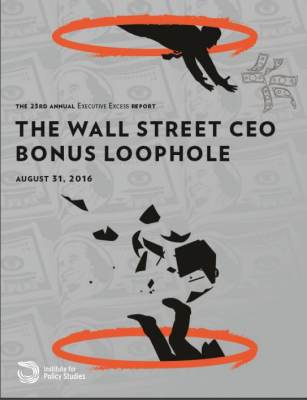 This report is the first to calculate how much taxpayers have been subsidizing executive bonuses at the nation’s largest banks.
This report is the first to calculate how much taxpayers have been subsidizing executive bonuses at the nation’s largest banks.
The study focuses on a 1993 Clinton administration reform that was intended to rein in runaway CEO pay by capping the tax deductibility of executive compensation at $1 million. But the new rule included a huge loophole for stock options and other “performance” pay. As a result, the more corporations hand out in executive bonuses, the lower their tax bill. This perverse incentive for excessive compensation has been a major factor in the explosion of CEO pay.
The financial bailout program closed this loophole for recipients, but only until they repaid their public funds. While homeowners and shareholders were still suffering from the crisis, banks began doling out massive stock-based awards that quickly ballooned in value, giving the banks huge tax write-offs and leaving ordinary taxpayers to make up the difference.
KEY FINDINGS:
- The top 20 U.S. banks paid out more than $2 billion in fully deductible performance bonuses to their top five executives over the past four years. At a 35 percent corporate tax rate, this translates into a taxpayer subsidy worth more than $725 million, or $1.7 million per executive per year.
- Wells Fargo CEO John Stumpf received the largest amount of such bonuses. Between 2012 and 2015, years in which his bank faced $10.4 billion in misconduct penalties, Wells Fargo received $54 million in tax subsidies — just for one man’s bonuses.
- Between 2010 and 2015, the top executives at the 20 largest banks pocketed nearly $800 million in stock-based “performance” pay — before their firm’s stock had returned to pre-crisis levels. With shareholders who had held on to their stock still in the red, executives were reaping massive bonuses that their banks could then deduct off their taxes.
This year’s IPS Executive Excess report, the 23rd annual, also includes the most comprehensive available catalog of CEO pay reforms, including proposed legislation to eliminate the CEO bonus loophole.
Read the full report here [PDF].
Share these graphics to help spread the word about how taxpayers are subsidizing Wall Street bonuses.
